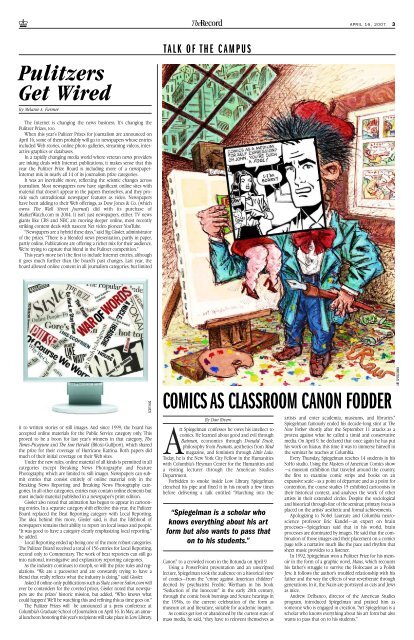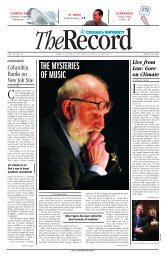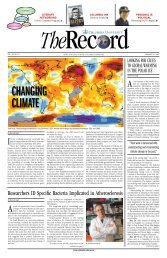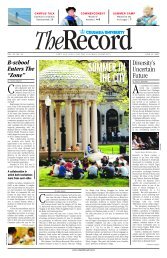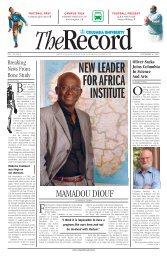2APRIL <strong>16</strong>, <strong>2007</strong>TheRecordRECENT SIGHTINGSMILESTONESANGELOS KEROMYTIS, associate professor in <strong>Columbia</strong>’sdepartment of computer science, has won a five-yeargrant of $750,000 from the Office of Naval Research,titled “Foundational and Systems Support forQuantitative Trust Management.” Along with fellowprofessors SAL STOLFO and JASON NIEH, Keromytis has alsowon a five-year grant of over $1.3 million from theUnited States Air Force titled “Autonomic Recovery ofEnterprise-Wide Systems After Attack or Failure withForward Correction.”DR. SARAH M. N.WOOLLEY, assistant professor in <strong>Columbia</strong>’sdepartment of psychology, has been named a <strong>2007</strong>Searle Scholar, one of an estimated 15 nationwide.The U.S. Congressional Budget Office has named Dr.SHERRY GLIED, department chair and professor of healthpolicy and management at the Mailman School ofPublic Health, to its panel of health advisers.DAVID FREEDBERG, professor in <strong>Columbia</strong>’s departmentof art history and archeology as well as the director ofthe Italian Academy for Advanced Studies, has beenappointed as the Pierre Matisse Professor of Art History.The Arts Council of African Studies Association hasawarded its Leadership Award to SUSAN VOGEL, professorin <strong>Columbia</strong>’s department of art history and archeology.ME AND MY SHADOW<strong>Columbia</strong> graduate students usually work under the wings of a professor, but on <strong>April</strong> 2 they became flock leaders to 38 high schoolstudents who spent the day at various schools throughout the <strong>University</strong>. On “Shadow Day,” high school students from New York andNew Jersey spent the day following <strong>Columbia</strong> graduate students in the fields of accounting, business, communications, criminal justice,education, engineering, French, fashion design, journalism, medicine, and psychology. Jonathan Alarcón (left) of Performing Artsand Technology High School in Brooklyn and Diego Morello (center) from John F. Kennedy High School in the Bronx shadowed HeidiButterman (right), an environmental engineering student. The Shadow Day participants are all recipients of college scholarships fromthe Los Padres Foundation, which sponsored the event for students of Puerto Rican descent who will be the first in their families togo to college. The Los Padres Foundation was founded by CU law alumnus Edgar Rios, ’77, and his wife Lillian.It’s Delightful, it’sDe-lovely, it’s De VinneUSPS 090-710 ISSN 0747-4504Vol. 32, No. 11, <strong>April</strong> <strong>16</strong>, <strong>2007</strong>Published by theOffice of Communicationsand Public AffairsTheRecord Staff:Interim Editor: Bridget O’BrianGraphic Designer: Scott HugStaff Writer: Dan Rivero<strong>University</strong> Photographer: Eileen BarrosoContact The Record:t: 212-854-3282f: 212-678-4817e: curecord@columbia.eduThe Record is published twice a month duringthe academic year, except for holiday andvacation periods. Permission is given to useRecord material in other media.David M. StoneExecutive Vice Presidentfor CommunicationsCorrespondence/SubscriptionsAnyone may subscribe to The Record for $27per year. The amount is payable in advance to<strong>Columbia</strong> <strong>University</strong>, at the address below.Allow 6 to 8 weeks for address changes.Postmaster/Address ChangesPeriodicals postage paid at New York, NY andadditional mailing offices. Postmaster: Sendaddress changes to The Record, 535 W.1<strong>16</strong>th St., 402 Low Library, Mail Code 4321,New York, NY 10027.printed on recycled paperwith soy based inks.TheRecord welcomes your input for newsitems, calendar entries and staff profiles.You can submit your suggestions to:curecord@columbia.eduDear Alma’s Owl,I thought Low Library was named afterSeth Low, but I just saw a sculpture ofsomeone named Theodore Low De Vinneon the first floor of Low. Is he any relation?— ResearcherDear Library Researcher,Low Library is the crown of<strong>Columbia</strong>’s campus, and it’s a commonmisconception that it was named afterLow, who was president from 1890 to1901. In fact, though, Low Library is amemorial to Seth’s father, Abiel AbbotLow. The bust you saw across from thetelephone booths on the first floor inLow is Theodore Low De Vinne (norelation to Seth). It’s one of three identicalbronzes by Chester Booth of DeVinne, a master printer and prolificauthor of scholarly books on typographyand publishing. De Vinne is portrayedin his working clothes, his headcovered with a floppy artist’s cap, historso resting on a stack of books, representinghis work, and a gear, which representshis industry and innovation inthe field of printing.Two of the busts are here at<strong>Columbia</strong>, one in Low and another inButler’s rare books room. The third is inthe Grolier Club of New York inMidtown Manhattan, America’s oldestand largest society for bibliophiles andenthusiasts in the graphic arts, of whichDe Vinne was founder and president.De Vinne received an honoraryMaster of Arts degree from <strong>Columbia</strong> in1901, in honor of his work as a printerand writer. He founded the De VinnePress, which produced a fine edition ofthe Anglican Book of Common Prayer,as well as the magazines ScribnersMonthly, St. Nicholas and CenturyMagazine. He created the Century typefacefor the latter. De Vinne’s printingASK ALMA’S OWLEILEEN BARROSOaccomplishments include fine-linewood engravings and halftone platesprinted as never before, but his crowningglory as printer was undoubtedlythe Century Dictionary, one of thelargest and most highly regarded encyclopedicdictionaries of the English language,printed with some 10,000 woodengravedillustrations. His histories ofprinting are still among the best workson the subject.My favorite among his accomplishmentsis the De Vinne Press building,which he commissioned on the cornerof West 4th and Lafayette Streets in theEast Village. Professor Andrew Dolkarthas called the massive brickwork andterracotta structure one of his fivefavorite buildings in New York, and itwould make my top five list too.The bust in Low Library was originallyaccepted by the <strong>University</strong> to beplaced in the entry of Avery Hall, thelocation of the architecture school, butnever made it to its intended home.Unfortunately, few people see it whereit is today.Send your questions for Alma’s Owl tocurecord@columbia.edu.DR. SAMUEL DANISHEFSKY, professor in <strong>Columbia</strong>’s chemistrydepartment, has been named the first-ever lecturerof the American Association for Cancer Research’sAward for Outstanding Achievement in Chemistry inCancer Research Lectureship.President LEE C. BOLLINGER has been nominated by TheWashington Post Co. to its board of directors.SOULAYMANE KACHANI, assistant professor of industrialengineering and operations research, has been honoredwith the Kim Award for Faculty Involvement. TheKim Award was endowed by Edward and Carole Kim,parents of Brian Kim (SEAS’01), and was established torecognize faculty members who go above and beyondthe call of duty to foster student success.CHRIS WIGGINS, assistant professor of applied mathematicsand applied physics, has been named the <strong>2007</strong>recipient of the Janette and Armen Avanessians(SEAS’83) Diversity Award. The Avanessians award honorsfaculty members who have made a significant contributionto the diversity of the School of Engineeringand Applied Science.THOMAS JAMES, current dean of the School of Educationat the <strong>University</strong> of North Carolina at Chapel Hill, hasbeen named the new provost of Teachers College, withthe accompanying titles of Dean and Vice President forAcademic Affairs. He will begin the job on July 1.SAMUEL DANISHEFSKY (below) has been named the firstever lecturer of the American Association for CancerResearch’s (AACR) Award for Outstanding Achievementin Chemistry in Cancer Research Lectureship. Theaward honors novel and significant chemistry researchwhich has led to important contributions in cancerresearch. Dr. Danishefsky is a professor of chemistry at<strong>Columbia</strong> and the Kettering Chair and Director of theLaboratory for Bioorganic Chemistry at MemorialSloan-Kettering Cancer Center.COURTESY: SLOAN-KETTERING INSTITUTE FOR CANCER RESEARCH
TheRecord APRIL <strong>16</strong>, <strong>2007</strong> 3TALK OF THE CAMPUSPulitzersGet WiredBy Melanie A. FarmerThe Internet is changing the news business. It’s changing thePulitzer Prizes, too.When this year’s Pulitzer Prizes for journalism are announced on<strong>April</strong> <strong>16</strong>, some of them probably will go to newspapers whose entriesincluded Web stories, online photo galleries, streaming videos, interactivegraphics or databases.In a rapidly changing media world where veteran news providersare inking deals with Internet publications, it makes sense that thisyear the Pulitzer Prize Board is including more of a newspaper-Internet mix in nearly all 14 of its journalism prize categories.It was an inevitable move, reflecting the seismic changes acrossjournalism. Most newspapers now have significant online sites withmaterial that doesn’t appear in the papers themselves, and they providesuch untraditional newspaper features as video. <strong>News</strong>papershave been adding to their Web offerings, as Dow Jones & Co. (whichowns The Wall Street Journal) did with its purchase ofMarketWatch.com in 2004. It isn’t just newspapers, either. TV newsgiants like CBS and NBC are moving deeper online, most recentlystriking content deals with nascent Net video pioneer YouTube.“<strong>News</strong>papers are a hybrid these days,” said Sig Gissler, administratorof the prizes. “There is a blended news presentation, partly in paper,partly online. Publications are offering a richer mix for their audience.We’re trying to capture that blend in the Pulitzer competition.”This year’s move isn’t the first to include Internet entries, althoughit goes much further than the board’s past changes. Last year, theboard allowed online content in all journalism categories, but limitedART SPIEGELMANit to written stories or still images. And since 1999, the board hasaccepted online materials for the Public Service category only. Thisproved to be a boon for last year’s winners in that category, TheTimes-Picayune and The Sun Herald (Biloxi-Gulfport), which sharedthe prize for their coverage of Hurricane Katrina. Both papers didmuch of their initial coverage on their Web sites.Under the new rules, online material of all kinds is permitted in allcategories except Breaking <strong>News</strong> Photography and FeaturePhotography, which are limited to still images. <strong>News</strong>papers can submitentries that consist entirely of online material only in theBreaking <strong>News</strong> Reporting and Breaking <strong>News</strong> Photography categories.In all other categories, entries may contain online elements butmust include material published in a newspaper’s print edition.Gissler also noted that animation has begun to appear in cartooningentries. In a separate category shift effective this year, the PulitzerBoard replaced the Beat Reporting category with Local Reporting.The idea behind this move, Gissler said, is that the lifeblood ofnewspapers remains their ability to report on local issues and people.“It was good to have a category clearly emphasizing local reporting,”he added.Local Reporting ended up being one of the more robust categories.The Pulitzer Board received a total of 156 entries for Local Reporting,second only to Commentary. The work of beat reporters can still gointo national, investigative and explanatory reporting categories.As the industry continues to morph, so will the prize rules and regulations.“We are a pacesetter and are constantly trying to have ablend that really reflects what the industry is doing,” said Gissler.Asked if online-only publications such as Slate.com or Salon.com willever be contenders for the coveted prizes, Gissler noted that newspapersare the prizes’ historic mission, but added, “Who knows whatcould happen? We’ll be watching this and refining this as time goes on.”The Pulitzer Prizes will be announced at a press conference at<strong>Columbia</strong>’s Graduate School of Journalism on <strong>April</strong> <strong>16</strong>. In May, an annualluncheon honoring this year’s recipients will take place in Low Library.SCOTT HUGCOMICS AS CLASSROOM CANON FODDERBy Dan Riverort Spiegelman confesses he owes his intellect tocomics. He learned about good and evil throughBatman, economics through Donald Duck,philosophy from Peanuts, aesthetics from Madmagazine, and feminism through Little Lulu.Today, he is the New York City Fellow in the Humanitieswith <strong>Columbia</strong>’s Heyman Center for the Humanities anda visiting lecturer through the American StudiesDepartment.Forbidden to smoke inside Low Library, Spiegelmanclenched his pipe and fixed it in his mouth a few timesbefore delivering a talk entitled “Marching into the“Spiegelman is a scholar whoknows everything about his artform but also wants to pass thaton to his students.”Canon” to a crowded room in the Rotunda on <strong>April</strong> 9.Using a PowerPoint presentation and an unscriptedlecture, Spiegelman took the audience on a historical viewof comics—from the “crime against American children”decried by psychiatrist Fredric Wertham in his book“Seduction of the Innocent” in the early 20th century,through the comic book burnings and Senate hearings inthe 1950s, to the current celebration of the form asmuseum art and literature, suitable for academic inquiry.As comics get lost or abandoned by the current state ofmass media, he said, “they have to reinvent themselves asartists and enter academia, museums, and libraries.”Spiegelman famously ended his decade-long stint at TheNew Yorker shortly after the September 11 attacks as aprotest against what he called a timid and conservativemedia. On <strong>April</strong> 9, he declared that once again he has puthis work on hiatus; this time it was to immerse himself inthe seminar he teaches at <strong>Columbia</strong>.Every Thursday, Spiegelman teaches 14 students in hisSoHo studio. Using the Masters of American Comics show—a museum exhibition that traveled around the country,the first to examine comic strips and books on anexpansive scale—as a point of departure and as a point forcontention, the course studies 15 exhibited cartoonists intheir historical context, and analyzes the work of otherartists in their extended circles. Despite the sociologicaland historical through-line of the seminar, primary focus isplaced on the artists’ aesthetic and formal achievements.Apologizing to Nobel Laureate and <strong>Columbia</strong> neuroscienceprofessor Eric Kandel—an expert on brainprocesses—Spiegelman said that in his world, brainprocesses are dominated by images. He said that the combinationof those images and their placement on a comicspage tells a narrative much like the pace and rhythm thatsheet music provides to a listener.In 1992, Spiegelman won a Pulitzer Prize for his memoirin the form of a graphic novel, Maus, which recountshis father’s struggle to survive the Holocaust as a PolishJew. It follows the author’s troubled relationship with hisfather and the way the effects of war reverberate throughgenerations. In it, the Nazis are portrayed as cats and Jewsas mice.Andrew Delbanco, director of the American Studiesprogram, introduced Spiegelman and praised him assomeone who is engaged in creation. “Art Spiegelman is ascholar who knows everything about his art form but alsowants to pass that on to his students.”


